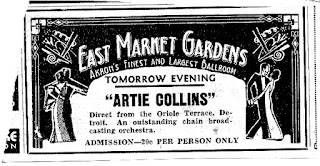Back in the days before television, Akronites—like everybody else—liked to get out of the house. There were always movie theaters to visit, and vaudeville shows, both professional and amateur. Live music was enjoyed just about everywhere, and dancing to it was equally popular. Younger generations enjoyed lacing up their roller skates and gliding across the floor.
In the 1920s and 30s, L. Oscar Beck—who also built the Civic Theater—erected a huge dance hall at 264 East Market St., just west of the First Congregational Church. This sprawling edifice, which stood on the site until 1984, was not only a popular recreation spot but was also host to some of America’s best-known musical acts, including Tommy Dorsey, Benny Goodman, Count Basie, Billie Holiday, Cab Calloway, Duke Ellington, and Harry James.
During the late 30s, the Garden was an especially popular spot for roller skating, as young people from all across town gathered to socialize, and display their skating technique and skill. My father would often take my mother there, demonstrating not only his skating prowess but his fancy skates, which featured battery-powered lights that twinkled as he rolled across the gleaming hardwood floor. He had rigged these up himself and liked to flick them on when they dimmed the rink lights at different times during the evening.
During World War II, the hall continued to be a popular spot, especially for many of the young women who took over men’s jobs at the rubber and aerospace factories. After the war, East Market Gardens was home to a number of other events as well, including the Children’s Hospital Charity Ball and The Greater Akron Trade Exposition.
 |
| The Greater Akron Trade Exposition - East Market Gardens, 1951 |
In later years, the hardwood floors would find another use, and the dance hall was eventually transformed into a bowling alley. Initially known as Garden Lanes, it was operated by Dick Behra until it was later sold to Barry and Sandy Keith and renamed Rubber City Lanes.
Bowling balls eventually gave way to the wrecking ball, when the big structure was torn down to make way for a Subway restaurant in 1984. As is so common in Akron, that building has already passed into oblivion and the site now is a vacant, concrete-paved lot.
 |
| From Bowling Balls to the Wrecking Ball - 1984 |






























